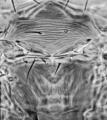Scirtothrips aceri
Recognition data
Distinguishing features
Both sexes fully winged. Body mainly yellow with shaded markings medially on head and laterally on tergites; tergal antecostal ridges weakly shaded medially; antennal segment II darker than I, segments III–VIII light brown; fore wings shaded. Head wider than long; ocellar triangle without sculpture, postocular region with transverse striae; 3 pairs of ocellar setae present, pair III close together behind fore ocellus. Antennae 8-segmented; III–IV with forked sensorium. Pronotum with widely spaced sculpture lines; posterior margin with 4 pairs of setae. Metanotum with irregular longitudinal reticulation; median setae close to anterior margin; no campaniform sensilla. Fore wing first vein with about 6 irregularly spaced setae on distal half, second vein with 5 widely spaced setae; posteromarginal cilia wavy. Abdominal tergites III–V median setae very small, about twice as long as the diameter of their basal pores; II–VIII with lateral thirds covered in closely spaced rows of fine microtrichia, these microtrichial fields with three discal setae, posterior margin with fine comb; tergite VIII comb complete, no discal microtrichia medially; tergite IX with no discal microtrichia. Sternites without discal setae; microtrichial rows only present laterally, not extending mesad of setae S2; posterior margins without comb of microtrichia.
Male smaller than female; tergite IX with paired drepanae; hind femora without comb-like row of stout setae; sternites without pore plates.
Related and similar species
The genus Scirtothrips currently includes 100 listed species from various parts of the world. Bailey (1964) provided keys to 13 from North America, but that work was based on specimens that were not fully cleared, and thus few structural details were available concerning differences between species. The identity and validity of certain of the species from California requires further study based on freshly mounted, fully cleared specimens. Similarly, Johansen & Mojica-Guzman (1999) provided keys to 33 species from Mexico, but doubts have been expressed concerning the biological reality of many of these (Mound & zur Strassen, 2001). Hoddle & Mound (2003) provided information on 21 Scirtothrips species from Australia, and Rugman-Jones et al. (2006) produced a molecular key to several pest species in this genus.
Taxonomic data
Current valid name
Scirtothrips aceri Moulton
Original name and synonyms
- Scirtothrips aceri Moulton, 1926: 122
Family placement
Thripidae, Thripinae
Biological data
Life history
Breeding on leaves
Host plants
Quercus sp. (Fagaceae)
Tospoviruses vectored
None
Crop damage
None
Distribution data
Area of origin
Western USA
Distribution
California coastal region (Bailey, 1964: 338)






